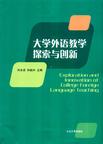大学外语教学探索与创新
2011-8
山东大学出版社
刘永波,孙祖兴 主编
840
1230000
在经济全球化和信息国际化的环境下,国际间的交流与交往日益频繁,外语的重要性日益凸显。因此,如何做好外语教学,提高学生的外语水平和参与国际交流与国际竞争的能力,是摆在我们面前的新任务。
为此,教育部近年来大力实施大学外语教学改革,先后颁布了大学和高职高专两个英语课程教学要求。我省高校积极参与外语教学改革,结合自身实际情况和培养目标,努力探索适合本校外语教学发展和特色的改革之路,取得了明显的成效。我省大学生英语学习成绩稳步提升,全国大学英语四、六级考试的成绩一直位居全国前列。
The Application of Constructivism in Oral English Teaching to
Non-English Majors
On Inverse Translation and the Teaching of C-E Translation as
Inverse Translation to Chinese Advanced EFL Learners
A Study of How Reading Ability Influences Writing Ability in Ll and
L2 Writing
Business English Teaching and Learning
Applying Autonomous Learning Theory in Teaching College English
Reading
On the Techniques of English Fast-Reading
English Language Listening: Process, Skills and Strategies
Nine Relationships in College English Teaching:A Developing
Perspective
Developing Confidence and Speaking Skill
-How to Motivate Chinese Students to Speak English in Class
Manifestations and Internal Causes of Chinese-English Interlanguage
Fossilization in Non-English-Major Freshmen
Integrated Development of Language Skills in College English
Teaching
The Influences of Individual Differences on Second Language
Acquisition
A Practical Intercultural Communication Study: "Chinese Culture
All-Dimensional Introduction &Adaptation" for Shandong Foreign
Language Experts
A Survey and Analysis of College English Teachers' Comment on
English Majors' Written Work: An Interpersonal Perspective
Applying Text Type Theory to Translation Teaching: An Empirical
Study
Language Ambiguity and Its Pedagogical Enlightenment on Foreign
Language Teaching A Study of Metacognitive Strategy Training for
Less Successful Non-English Majors in Universities
The Relevance-.theoretic Approach to Context and Its Implications
for Teaching Foreign Language Reading
Teaching Reform on Comprehensive English: In Light of John Dewey's
Pragmatism
Construction of New Teacher-Student Relationship Based on
Questioning Strategies
The Application of Cognitive Context to Text Comprehension and Its
Implications for College English Reading Teaching
Productive Pedagogy-A Method for Reference in China's English
Teaching Application of Discourse Analysis to Teaching College
English for Non-English Majors
An Experimental Study of Training College Students to Use Cohesive
Devices in Writing
Application of Textual Cohesion Theory to Teaching Cloze Test in
CET-4
The Reliability& Validity of Peer Assessment in Oral English
Class in First-Year College Students
Advance the Reforms in Video and Speaking Course and Improve the
Teaching Quality
The Influence of Sino-Foreign Education Program on English Teaching
in Vocational Colleges
……
Rixon(1986)provides a commonsense way of dividing up a listening lesson into three phases: things to do before the students hear the passage, activities and exercises to be carried out as the students listen to the passage and things to do once the class has come to grips with the meaning and content of the passage. Mary Underwood(1989)recognizes three stages of teaching: pre-listening, where the students activate the in vocabulary-and their background knowledge; while-listening, where students develop the skills of eliciting messages; and post-listening, which consists of extensions and developments of the listening task. When English language teachers prepare or conduct the activities or tasks indifferent stages, they should keep in mind the following points.(1)Make good use of pre-listening activities to make students ready to gain the most from the passage. Hedge(2000)states that the purpose of pre-listening activities is to contextualize the passage, provide relevant information about the passage and create motivation and confidence. Ur(1984)also suggests that it would be a good idea when presenting a listening passage in class to give the students some information about the content, situation and speaker(s)before they actually start listening. Some possible activities include: pre-teaching some information or knowledge related to the listen ingmaterial, discussing pictures, predicting, group discussion, etc. (2)At the while-listening stage there should be something interesting to listen to and a purpose for listening(Underwood, 1989). The main purpose of while-listening activities is to challenge and guide students to handle the listening comprehension process successfully. Hedge(2000)points out that the work at the while-listening stage needs to link in relevant ways to the pre-listening work and teachers should encourageee students to attend to the text more intensively or more extensively, for specificinformation or for gist. (3)Teachers should attach much importance to post-listening activities with more choices of activity types. Activities at this stage can be much longer because students have time to think, to discuss, to write and activities should have some purpose of it sown and is motivating(Underwood, 1989). Post-listening activity can take students into a more intensive phase of study(Hedge, 2000). (4)Make good balance of the three-stage activities. Chinese teachers tend to payless, or even no, attention to pre-listening and post-listening activities, which also play an important role in improving students' listening ability. But Teachers should lavoidpre-teaching the language of the listening passage, or telling students too much about the topic or the information contained in it, as this removes the challenge and interest.Field(1998)also claims that listening lessons are often top-heavy with an extended pre-listening period. A revised lesson model might feature a shorter pre-listening period,which focuses on creating motivation and establishing context. There would be an extended post-listening session(possibly in a subsequent lesson)in which gaps in learners' listening skills could be examined and redressed through short micro-listeningexercises.(5)Put skills training and strategies instruction into three-stage activities.Activities in different stages need to be as relevant as possible to the students and should mirror real life. Activities need to be task-based, which are creative-designed, well-structured, with opportunities for students to activate their own knowledge and experience and to monitor what they are doing. Skills training and strategies instruction can be incorporated into these activities and tasks. (6)There are many examples of tasks and activities specifically designed for pre-,while- and post listening stages in the book of Underwood(1989)"Teaching Listening", which can be consulted by teachers. ……

为什么发票不可以按书后边的价钱来开呢,开的是优惠后的价钱